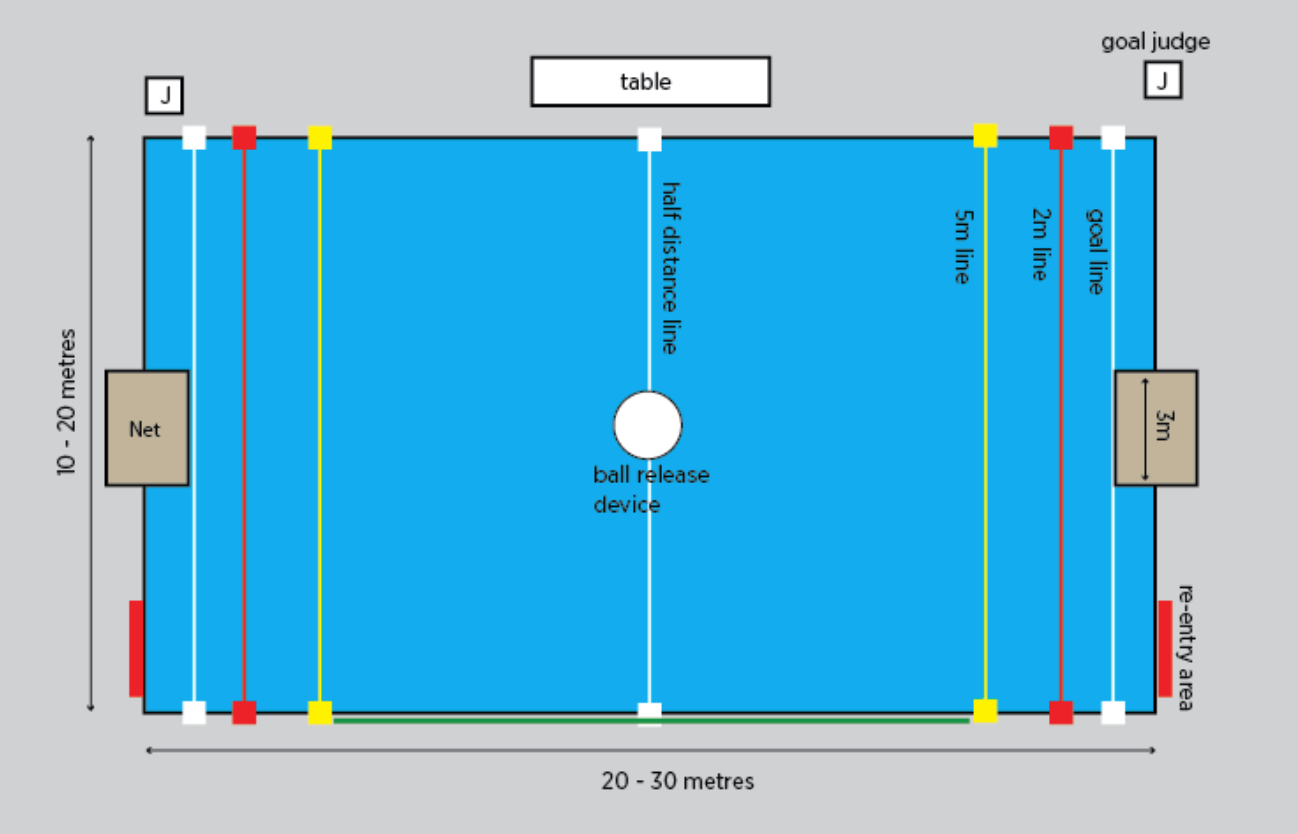ABOUT WATER POLO
CLICK HERE TO DOWNLOAD A SPECTATOR'S GUIDE TO WATER POLO
For quick reference keep scrolling...
FIELD OF PLAY
The pool is divided into areas by colored cones (or markers) along the side of the pool.
-
Goal line: white markers or cone
-
2 meter line: red markers or cone
-
5 meter line: yellow markers or cone
-
Mid-pool: white marker or cone
For each of the above lines (or areas of the pool), watch for the following:
Goal line: A goal counts only when the ball goes completely across the goal line and into the goal (close does not count); the ball is out of bounds if it goes completely across the goal line and not into the goal.
2 meter line: No offensive player is allowed to swim inside of the 2 meter line unless he/she has possession of the ball.
5 meter line: If a defensive player commits a foul inside of the 5meter line which prevents a “probable goal,” the defensive player is charged with a penalty (personal) foul and the opposing team is awarded a penalty throw (a “5meter”). If an offensive player is fouled outside of the 5meter line, the offensive player may pick up the ball and take an immediate shot at the opponent’s goal (i.e., two players do not have to touch the ball before a goal can be scored).
Mid-pool: After each goal is scored, play is restarted at mid-pool; the goalkeepers are not permitted to go across the mid-pool line.
PLAYERS
-
Each team must have seven players (six field players and one goalkeeper.)
-
The visiting team’s field players wear white (or light colored) caps, the home team’s field players wear blue (or dark colored) caps.
-
The goalkeepers wear red or “quartered” (red plus another color) caps.
-
Either team may substitute players freely after a goal is scored, during a timeout, or between periods.
-
During actual play, substitutions must occur through the team’s reentry area (the corner of the pool in front of the team’s bench).
-
If an illegal player (i.e., an 8th player or a player who has fouled out of the game) enters the field of play, that player is excluded from the remainder of the game and the opposing team is awarded a penalty throw.
THE “ADVANTAGE RULE”
The referees shall refrain from declaring a foul if, in their opinion, such declaration would be an advantage to the offending player’s team. The referees shall not declare an ordinary foul when there is still a possibility to play the ball. The referees shall apply this principle to the fullest extent. They should not, for example, declare an ordinary foul in favor of a player who is in possession of the ball and making progress towards the opponent’s goal, because this is considered to given an advantage to the offender’s team
(NISCA Rule 7.3).
If a referee believes that a foul is an advantage to the player committing the foul, then the referee should not call that foul. There is an important caveat to this rule player safety. Any foul that endangers a player’s safety, especially fouls around a player’s head and neck, must be called.
OFFICIALS' HAND SIGNALS

FOULS
Ordinary Foul: The most common type of foul is called the “ordinary foul.”
-
For an ordinary foul, the referee blows the whistle once and points in the direction of the attack (i.e., the direction that the offensive team is moving).
-
The player who was fouled (or a teammate) puts the ball into play by taking a free throw. If the ordinary foul is against a defensive player, the offensive team retains possession of the ball and takes a free throw.
-
If the ordinary foul is against an offensive player (an “offensive foul”), the defensive team takes possession of the ball and takes a free throw.
-
If a defender interferes with the taking of the free throw, the defender is excluded (ejected or “kicked-out,” see below)
-
In most cases, a player taking a free throw cannot take a shot at the opponent’s goal.
-
During the period of time between the referee’s whistle and the taking of the free throw (“dead time”), players may continue to swim and strive for position (i.e., play does not stop).
-
Examples of some common ordinary fouls include (but are not limited to):
-
Touching the ball with two hands (does not apply to goalkeeper inside of the 5-meter line).
-
Walking on or pushing off the bottom of the pool (does not apply to the goalkeeper inside of the 5-meter line).
-
Impeding a player who is not holding the ball.
-
Throwing the ball out of the field of play.
-
Failing to take a shot within 30 seconds (letting the shot clock expire).
-
There is no limit to the number of ordinary fouls that a player can commit during a game.
Exclusion Foul a.k.a ejection or kickout
-
For an exclusion foul, the referee blows the whistle several times, points in the direction of the attack with one arm, and with a sweeping motion of the other arm signals the player to the team’s reentry area (the corner of the field of play immediately in front of the team’s bench).
-
The player who was fouled (or a teammate) puts the ball into play with a free throw. As above (“ordinary foul”), play does not stop during “dead time.”
-
The excluded player must swim to the team’s reentry area without interfering with play.
-
If an excluded player interferes with play, that player is charged with a penalty foul and the offended team is awarded a penalty throw.
-
An excluded player may reenter the game when:
-
There is a change in possession.
-
A goal is scored.
-
20 seconds of playing time elapses.
-
The referee signals a change in possession.
-
-
When reentering the game from the reentry area, a player may not push off the side or bottom of the pool.
-
An exclusion foul is a “personal foul.”
-
If a player receives three personal fouls (exclusion + penalty fouls), he/she is excluded from the remainder of the game with substitution.
-
Examples of exclusion fouls include (but are not limited to):
-
Holding, sinking, or pulling back a player who is not holding the ball.
-
Interfering with the taking of a free throw.
-
Splashing water in an opponent player’s face.
-
To commit an act of misconduct (e.g., obscene or abusive language) or disrespect.
-
If a player exits the pool from anywhere other than the reentry area during actual play (i.e., climbs out of the water along the edge of the pool), it is considered disrespect. The player would be excluded from the remainder of the game with substitution.
-
Brutality (a player who commits an act of brutality is excluded from the remainder of the game without substitution).
-
Penalty Foul
For a penalty foul, the referee blows the whistle twice and then raises his/her hand above the head with five fingers extended.
It is a penalty foul to commit any offense within the 5-meter line that prevents a team from scoring a “probable goal.”
When a penalty foul is called, the offending player is charged with a penalty foul (a “personal foul”) and the opposing team is awarded a penalty throw (a “5-meter”).
If a team is awarded a penalty throw, any player on that team, except the goalkeeper, may take the penalty throw.
The player taking the penalty throw must take the throw from the offensive 5-meter line.
With floating goals, the defending goalkeeper must be entirely inside of goal (i.e., inside of the goal and behind the goal line). With wall-mounted goals, the goalkeeper’s hips must be on the goal line.
TIMEOUTS
Each team may call three timeouts during the four quarters of regular play.
A team may call only one timeout during any overtime periods.
Regular timeouts are 2 minutes long; short timeouts (indicated when coach taps his shoulders) are 30 seconds long.
When the ball is in play, only the team in possession of the ball may call a timeout.
If the offensive team calls a timeout, the defensive team may call a timeout before the ball is put into play.
Either team may call a timeout after a goal is scored or before the taking of a penalty shot.


